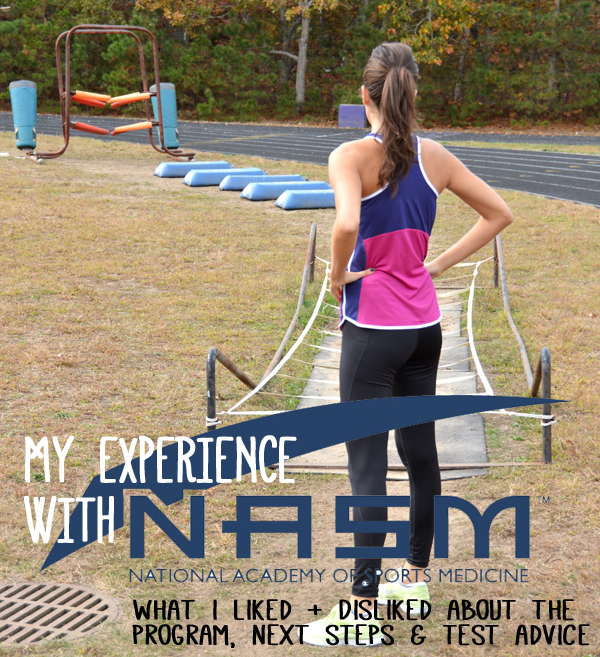
I typically try to keep my posts here short ‘n sweet, but I wanted to cover all the details of my experience with the NASM CPT program. This is a long post, but hopefully all you interested in getting your PT cert will gain some useful insight from it.
Why I Chose NASM
In deciding which personal training certification to get, it seemed there were three options: ACE, NASM and ACSM. I quickly ruled out ACE because I read a ton of dissatisfied reviews from people saying the gym they wanted to work at wouldn’t accept the ACE certification. Because the ACE exam has the highest pass rate, the assumption is that it’s the easiest of the three certifications to get, and therefore not as highly regarded as the other two.
So it was down to NASM and ACSM. Honestly, had I spent a little more time talking to trainers I know instead of solely relying on online research, I would have gone with ACSM. In the future, I might actually get an additional cert from them. ACSM has the lowest pass rate (=hardest test) and is the only program to require candidates have a college degree. A couple trainers I spoke with after already signing up for NASM were adamant that ACSM was the way to go, but that ship had sailed.
That’s not to say NASM isn’t highly regarded. In most of the reviews I read, people agreed that any gym would be happy to hire a personal trainer with either a NASM or ACSM certification—it didn’t matter. NASM even cites ACSM research in their textbook, so I think at the end of the day, you’re getting a lot of the same information from either program. The main difference between the two I gathered from researching reviews online was that NASM emphasized training the vast majority of the American population, while ACSM was a better choice if your goal was to train high-level/professional athletes.
Choosing a NASM CPT Package
There are five different packages you can chose from when signing up for the CPT cert through NASM. They range in price from $699 for the most basic self-study package, to $1,999 for the most inclusive package that comes with job guarantee, free re-test and an associate personal trainer experience. I went with the cheapest, self-study package because 1. holy f*cking shit I’m not spending two month’s rent on anything and 2. I’m a huge nerd—I love studying, I’ve always been “good at school,” and I was confident I could teach myself the material and pass the exam without the added access to online classes, live workshops, etc.
So basically I spent $699 on a textbook, access to some online study materials and a test. Makes me angry every time I think about it, but sadly, that’s just life when it comes to pretty much any sort of degree or certification.
What I Liked about the NASM CPT Program
NASM lays down an excellent foundation of knowledge and will prepare you to train the majority of clients you’d encounter. I guess what was kinda sad for me during studying was the realization that the majority of clients you’d encounter (aka the majority of Americans) are sedentary, completely deconditioned, and afflicted by one or more chronic diseases like diabetes, cardiorespiratory diseases or hypertension. The program focuses a lot on dealing with these issues and either training around them or how to improve them.
While it is sad that our country is so afflicted by obesity and other chronic diseases, I’m really happy I have the knowledge base to work with and help this majority population. I found it so interesting to learn about today’s common postural imbalances (hunched shoulders from sitting at a desk, for example) and how to improve them by strengthening certain muscles and stretching others. While NASM doesn’t introduce you to any creative exercises or workout routines, it definitely will help you create more informed and effectively targeted workouts.
I actually already have been using what I learned on myself! My feet pronate slightly when I run (rotate inward). Whereas before I thought of it simply as a permanent trait of mine, now I’m conscious of trying to strengthen certain muscles and improve the flexibility of others in order to improve this pronated posture. Thanks to NASM, I am definitely better able to create workouts that address specific issues or goals, which is awesome. I feel much better educated in this respect.
What I Disliked about the NASM CPT Program
While it gave me a great foundation of knowledge and I feel confident I could create a training program for the majority of people out there (elite athletes excluded), I was left feeling like That’s it? Ok…what’s next?
You won’t learn any new exercises through this certification; it won’t help you make creative, innovative workout routines and training programs; you won’t be an expert in any specific mode of fitness; and it pretty much focuses on working out in gyms. This NASM cert will 100% prepare someone for getting a personal trainer position at a gym; but since that’s not really my goal, I was a little disappointed.
The bottom line is that now that I have this awesome foundation of information (because NASM really does do an excellent job of teaching you the basics), it’s time to get the necessary certs and training experience in the specific areas I love: kettlebell training, Lagree method Pilates, spinning, etc.
NASM Exam Advice
I can’t talk too much about the test—pretty sure that’d be cheating. But I would say definitely know your vocab, and also be familiar with muscle locations and functions so that you have an understanding of which would be affected during different exercises or postural imbalances. Also, definitely take the practice test NASM offers on their website. It gives you a great idea of the types of questions you’ll see.
You have six months to take the exam from the time you sign up. Before taking the exam you need to get your CPR/AED cert, if you don’t already have a current one. I signed up in July, but didn’t start studying until November. I spent the last month studying and then took the exam. You have two hours for the test, which is made up of 120 multiple choice questions. Only 100 count towards your score, but you don’t know which ones. It took me just under an hour to finish. You won’t get a numerical score, just a PASS or FAIL. One final piece of advice—try not to look like a total disaster when you go in for the test; they take your picture. Wish. I’d. Known.
Let me know if I didn’t cover anything or you have other questions! And for more info visit NASM.org.
xo Nicole
Links to NASM are affiliate.







